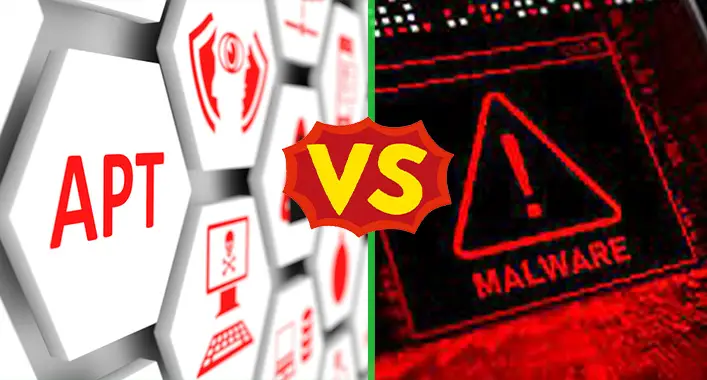Differences Between APT and Malware | Cyber-Attacks
The cyber-threats and cyber-attacks are evolving day by day. APT is a modern-day cyber attacking process that is used to cause huge damage to any most secured system’s infrastructure. Malware attacks are another type of cyber-attacks, that is conducted by injecting malicious codes or programs. In this article, we’ll be discussing the differences between APT attacks and malware attacks.

What are the Differences Between APT and Malware?
There are some differences between APT and malware attacks. APT attacks are more successful cyber-attacks compared to textbook malware attacks. Here are the differences between the APT and malware attacks;
| APT | Malware | |
| About | Advanced Persistent Threat or APT is a type of cyberattack that can gain an unauthorized foothold to execute extended and continuous attacks for a long time. It is a broad term that is used to describe an attack campaign. The APT attack can be conducted by multiple intruders at the same time. It requires an illicit and long-term presence on the targeted computer network. These attacks are executed manually against a specific mark and a large pool of targets. The APT attacks are sometimes used as cyber warfare. By executing this type of cyber-attack, the attacker can take control of the total site to sabotage the infrastructure of an organization. Also, the attacker can collect or destroy the database of the victim. | Malicious software, commonly known as Malware. It is designed and produced for damaging, destroying, stealing data, and taking control of computers and networks. Malware uses various techniques to infiltrate operating systems and files. Typical Malware infects machines and devices by tricking the user to click or install a program from the internet. Successful execution of malware depends on the tricks used by the attacker. The cybercriminals develop and inject the malware into a network or computer system to steal data and cause damage. An attacker can easily execute malware attacks for short time. Using the malware, the attacker cannot take full control over the system. Though, recent malware attacks can cause huge damage for a long time to a system. |
| First Introduced | 2005 | 1949 |
| Entranceway | DDoS attacks, SQL injection, backdoor, malicious uploads. | Internet and programs, online-offline, system vulnerabilities. |
| Time Period | Long time. | Both short and long time. |
| Conducted By | Multiple attackers. | Both single and multiple attackers. |
| Conducted For | Stealing intellectual property (patent trade or treaty information), sabotaging infrastructures, taking control the site. | Damaging, destroying, stealing data, taking control. |
| Attack Cost | Costly, requires heavy finance. | Comparatively cheaper. |
| Attack Range | Broad. | Small. |
| Conduction Stage | 3 (1. Infiltration, 2. Expansion, 3. Extraction) | 5 (1. Entrance, 2. Traffic Distribution, 3. Exploitation, 4. Infection, 5. Execution) |
| Usage as Cyber Warfare | Yes | No |
| Conduction Process | Manually | Both manually and automatic. |
| Hit and Run | No | Yes |
| Examples | Stuxnet, Hydraq. | Computer viruses, computer worms, ransomware, keylogger, trojan horses, spyware and other forms of malicious software. |
| Protection | Traffic monitoring, application and domain whistling, controlling access of the network. | Anti-malware software, firewall, avoiding dodgy sources, keeping the updated version of driver and programs. |
Is APT a Malware?
As you already know, the APT is a strategic and stealthy approach that is manually conducted by a team of cyber attackers. While malware attacks are a kind of quick approach to damaging or controlling the system. In some APT attacks, the attacker uses malicious codes to access the system. Malware refers to malicious programs, whilst APT is a process to get access to a system for a long time. So, you can flag APT as a cyber-warfare rather than malware.
What Is the Major Difference between an APT and a Normal Attack?
The APT attacks are more organized and strategic attacks compared to normal cyberattacks. Intruders can remain undetected for a long time on a system through APT, which is pretty impossible in normal cyberattacks. There are too many drawbacks of normal cyberattacks when the APT attacks have minimum drawbacks. These are the major differences between the APT and a normal cyberattack.
Are the APT and the Zero-Day Hacking Same?
No, the APT and the Zero-Day hacking are not the same. APT is a combination of many attacking processes when the Zero-Day hacking is conducting attacks on multiple systems at the same time by using exploits and system vulnerabilities. The combination of APT and Zero-Day hacking could be dangerous for computer systems and data all over the world.
Frequently Asked Questions (FAQs)
What Can Make Malware Attacks Successful?
A successful malware attack depends on the Successful execution of the malware, which depends on the tricks used by the attacker. These tricks can con the target and turn them into a victim.
Who Are Advanced Threat Actors?
The advanced threat actors or malicious actors are generally an individual or an organization who are entirely or partially responsible for cyberattacks. In most cases, the threat actor has or had some kind of external privilege on the system.
Why Are APT Attacks More Successful?
The reason of being APT attacks more successful is the level of effort needed to conduct it. This attacking process is more organized than any other cyberattack, and this process doesn’t apply any hit-and-run process. These reasons are responsible for making it more successful.
Finishing Lines
The core differences between the malware attacks and the APT are in the execution process of them. Most textbook malware attacks are hit-and-run attacks, while the APT attacks are stealthy and organized. The APT can be used as a modern cyber-warfare.
![[ANSWERED] Does Malwarebytes Scan All Drives?](https://cyberselves.org/wp-content/uploads/2023/07/Does-Malwarebytes-Scan-All-Drives.webp)

![[Explored] What Is Cloning in Cyber Security?](https://cyberselves.org/wp-content/uploads/2022/06/What-Is-Cloning-in-Cyber-Security.jpg)

